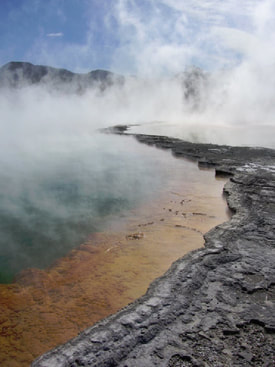|
"Champagne pool", Waiotapu,
New Zealand. |
Harnessing the furnace beneath our feetMost people are familiar with spectacular thermal areas like Old Faithful in Yellowstone National Park, or the geysers of Iceland. Countries like Italy, Iceland, New Zealand, Japan, the U.S., and Indonesia have been making use of such geothermal heat with major power stations for decades. These typically use very active geothermal areas to generate steam.
Yet the Earth's heat is not limited to such areas. The temperature of the Earth increases routinely as a function of depth wherever we are. Increasingly, with ever more efficient technologies, this fact is being used to heat water, not just steam, and harness this energy - even around the UK. Unlike other renewables such as wind or solar, this energy stream is constant and reliable, and as long as the earth's core and mantle has radioactive elements - and that's a pretty long time - it will continue. PAETORO is further researching applications of geothermal heat in the UK and around the world - particularly Central and southeastern Europe, the Middle East, and South America. We are compiling databases of related information to understand what might work, and where it doesn't seem to - what the issues are. |
A particular interest is customer driven exploration - understanding what the customer needs first and foremost, translating this to faculties engineering, and then to available resource. Industrial use of geothermal heat and power is a particular theme of interest. Paetoro is working with a number of experts and organisations worldwide to fully optimise the drilling, engineering, geophysical, geochemical, geological, and commercial aspects of this complex resource.
Particular topics of current research are listed below (further links will be activated shortly), and see also the Paetoro Blog page for more articles on the subject, and the Paetoro Events page for recent papers and presentations.
Particular topics of current research are listed below (further links will be activated shortly), and see also the Paetoro Blog page for more articles on the subject, and the Paetoro Events page for recent papers and presentations.
- Global geothermal potential
- Geothermal UK
- Geothermal in South America
- Geothermal Desalination
- Geothermal Galicia
- Geothermal of Central & SE Europe
- Geothermal direct use heat for industry
- Geothermal exploitation of radiothermal granites

